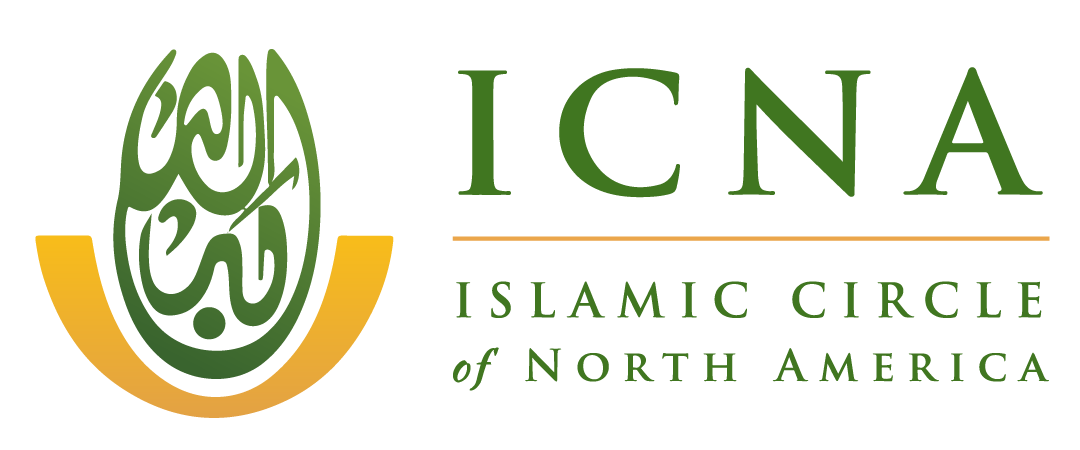ICNA Declares Friday, October 13, 2023, As a Day of Du’a.
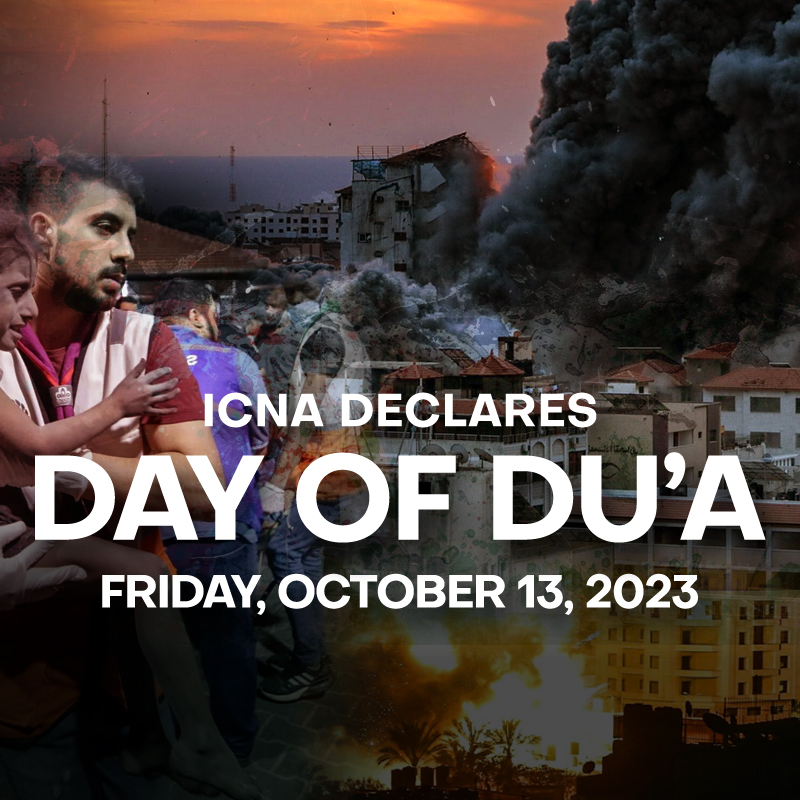
We call upon Khateebs, community Leaders and Politicians in the US to educate the community and all Americans about the dire humanitarian situation in Palestine and to pray for their safety, freedom, and well-being of all those including innocent civilians, women and children. Here are some facts and the talking points to be discussed: 1. Netanyahu’s far-right government intensified Israel’s violent repression upon Palestinians since taking power earlier this year. Defense Minister of Israel called Palestinian as “animals”, denying them any food, electricity and water • Before the latest surge in violence, Israeli soldiers had already killed more than 250 Palestinians, including at least 47 children, in the occupied West Bank only in 2023, more than any year since the Second Intifada, or uprising, against Israel’s occupation in the early 2000s. • Extremist Israeli settlers had also ramped up their attacks on Palestinians to push them off their land earlier this year. In August 2023, the UN warned of a dramatic increase in settler violence, with nearly 600 attacks recorded in the first six months of JUST THIS year, averaging 99 incidents each month. • Israeli extremists have also increased their provocations in and around the Noble Sanctuary Mosque complex in occupied East Jerusalem, the third holiest site in Islam, which they wish to destroy. 2. Gaza has been under brutal Israeli military occupation for more than 50 years. • Under international law, Gaza remains under Israeli military occupation, despite Israel’s withdrawal of settlers and soldiers from the interior of Gaza in 2005, it continues to control virtually all entry and exit, as well as Gaza’s airspace and coastline. 3. Israel has imposed a ruthless, illegal siege and naval blockade on Gaza for more than 15 years. The former British Prime Minister, David Cameron, said, “People in Gaza are living under constant attacks and pressure in an open-air prison,”. • More than 2.3 million Palestinians are in Gaza, trapped under Israel’s draconian siege and naval blockade, unable to travel to get medical treatment, go to school, or visit family and friends, deprived of basic needs and supplies. Gaza’s economy has been devastated by the siege and blockade, and by repeated Israeli military assaults that have destroyed much of Gaza’s civilian infrastructure. The siege and blockade have been repeatedly condemned by the UN and human rights organizations as a form of collective punishment and illegal. 4. Most Palestinians in Gaza are refugees, expelled from what became southern Israel in 1948. • Two-thirds of Palestinians in Gaza are refugees who were expelled from their homes during Israel’s establishment in 1948, denied their internationally recognized legal right to return simply because they aren’t Jewish. 5. The source of the problem is Israel’s brutal military occupation and apartheid system that was established in 1948. • In the words of Amnesty International: “Israel has established and maintained an institutionalized regime of oppression and domination of the Palestinian population for the benefit of Jewish Israelis – a system of apartheid – wherever it has exercised control over Palestinians’ lives since 1948.” The only way to end the violence is to end Israel’s occupation and apartheid system. • Israel ‘can no longer control its own fate’ after stunning Palestinian attack Veteran Israeli analyst Meron Rapoport told MEE that the Israeli military and intelligence is at a new low, and it may prove terminal for Netanyahu and his settler government. • Palestinian President, Mahmoud Abbas, said on Saturday that the Palestinian people have the right to defend themselves against the “Israeli crimes and violations in Al-Aqsa Mosque compound and the Palestinian Territories”. 6. American Muslims urge all Muslim countries and their leadership, particularly those who are eager to build their relationships with the Zionist regime, to reconsider their plans and not compromise on the just cause of the oppressed Palestinians. 7- We call upon the people of conscience to recognize the hypocritical stances of many nations when it comes to the human rights violations against the Palestinian people, and to condemn these senseless attacks. 8- Express support and the need for an immediate ceasefire. Demand the United States to reassert its leadership role as a negotiator in pursuit of a lasting peace. This entails addressing the root causes of violence, terminating Israel’s occupation of Palestinian territories, and ending the Israeli government’s apartheid policies. Finally – we ask Allah SWT for His help, guidance and support. May He free the oppressed people around the world, including people of Palestine, and prevent the oppression of the oppressors. Ameen. Events to Remember: American Muslims for Palestine and AJP Action are holding an advocacy day on Capitol Hill. It will take place in Washington DC on October 23rd and 24th to lobby congressional representatives in holding Israel accountable for its crimes, to recognize it as an occupying apartheid state, and to advocate for Palestinians. Please fill out and share widely in your networks it’s important that our elected representatives’ offices get flooded by their constituents’ messages – takes 30 secs and simple https://na01.safelinks.protection.outlook.com/?url=https%3A%2F%2Faction.cair.com%2Fa%2Fgazaunderattack&data=05%7C01%7C%7C36882fe76db545d90c9708dbcae736a9%7C84df9e7fe9f640afb435aaaaaaaaaaaa%7C1%7C0%7C638326866633394624%7CUnknown%7CTWFpbGZsb3d8eyJWIjoiMC4wLjAwMDAiLCJQIjoiV2luMzIiLCJBTiI6Ik1haWwiLCJXVCI6Mn0%3D%7C3000%7C%7C%7C&sdata=vRfR3Kb6FSMWx5dIvEyV9fUIDRhhpmtKrlzVvkJsiSw%3D&reserved=0 AMP will also be holding a Day of Action and rally on Saturday, October 14th, at 1 p.m. in front of the White House. For updated information, please visit the AMP website or follow their social media pages. As much as it is necessary to raise our voices, it is also necessary to donate. Helping Hand for Relief and Development (HHRD) www.hhrd.org is collecting money to donate food and supplies to the Palestinian people. This is a time of dire need for our brothers and sisters, who are not able to access even basic necessities for survival and are under blockade by their occupiers. Donate to our campaigns through HHRD here
Why Muslims Need to Talk About Hispanic Heritage Month
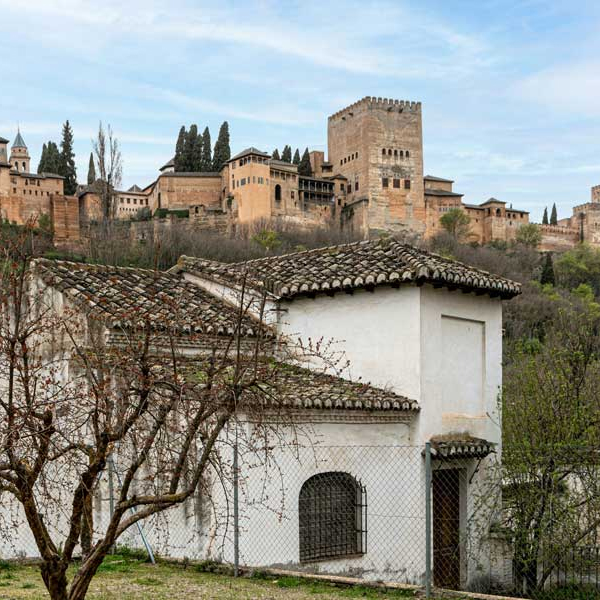
One of my earliest experiences at an Islamic conference was when I attended the ISNA Convention in Washington D.C. over two decades ago. It was the first time the Islamic Society of North America held its annual convention in D.C., after establishing it in Chicago for the previous 38 years. It was also its first large event after the attacks of September 11, 2001. The inaugural session of the 39th Annual Convention in 2002 opened with a solemn prayer for the victims of the 9/11 terrorist attacks. The theme of the convention was “A Call for Peace and Justice,” and began with moving speeches from a multitude of Muslim leaders from around the country. Among the many leaders who made statements during the opening session was Imam Benjamin Pérez, whom I would later meet at a session by and about Latino Muslims. Prior to leaving my house for the conference, I grabbed a pin with a Puerto Rican flag and secured it on my hijab, above my heart. I had only been Muslim for three years, and I was living in Maryland at the time. I did not know many Latino Muslims personally, so I held the hope that if there were any present at the ISNA convention, they would notice my pin and approach me. As I zigzagged through the crowd of Muslims, hoping to spot another Puerto Rican or Latin American, I was utterly disappointed. In the sea of familiar-looking faces, there was not one that shared my background. But just when I started to lose hope, a friend pointed out a session on the convention’s printed program. There was a panel discussion about Islam among Latino Americans whose speakers included Muslims with Spanish names. When I checked the session’s time, I realized that it had already started, so I took note of the hall number and sprinted there. When I made it to the conference room completely out of breath, it was packed. There were only a few seats left, so I made my way to an empty chair and sat down to listen, in awe of the mostly Latino Muslim panel. It was the first time I heard Muslim leaders who shared some of my cultural background. The panelists included Mexican American Imam Benjamin Pérez (may Allah have mercy on him), a Dominican brother named Isa Contreras, and others. They spoke about the growing number of Latin Americans embracing Islam, their own experiences embracing Islam in their respective communities, and the work that still needed to be done to bridge the gap between Muslims and our Spanish-speaking neighbors. After their presentations there was a question-and-answer session, so I eagerly stood up, approached the available microphone, told them my story, and asked how I could get in touch with other Latino Muslims. I think I was still catching my breath when I suggested I get the contact information of the Latin American Muslims on the panel so I could stay in touch with them. Finding others like me was important, because even though Muslims all constitute one brotherhood and sisterhood, human beings tend to seek out people of similar backgrounds and experiences. Through this meeting, I was introduced to the Latino American Dawah Organization (LADO) led by Mexican American Juan Galvan, whose online presence on Yahoo! Groups allowed me to connect with Latino Muslims from around the country. In the following years, I would develop relationships, join dawah efforts, and volunteer at different organizations to translate material into Spanish. Eventually, when I married another Hispanic convert, together we founded an organization called Hablamos Islam(We Speak Islam) with the purpose of creating educational resources about Islam in the Spanish language, with Latino families in mind. Eventually, it also evolved into creating programming and literature for children. Dawah organizations often forget to factor the youth into their outreach efforts, but when Latino families are entering the faith in rising numbers, it is only natural that they need educational tools for their children. I learned this firsthand. During this whole process, I had children of my own, and now my eldest is in his late teens. Although Latino Muslims were becoming increasingly visible– seeking higher Islamic education and forming their own organizations and programs – there were (and still are) areas of outreach that are lacking. Fast-forward over twenty years later to 2023. Allah has a way of bringing things full circle. A few months ago, I had the pleasure of helping to organize and participate in the Spanish sessions at the ICNA-MAS Convention 2023 in Baltimore, Maryland. I was not a newcomer, having been involved in the planning of Spanish language, convert, and sisters’ programs since 2010. Yet after over a decade of involvement in the weekend-long, eman-boosting conference, I noticed something different in the audience. This time as I sat on a panel with two other Latino speakers, I saw something incredible. Two young couples walked into the hall, and I recognized the wives – both were South Asian and daughters of two sisters I knew personally but I had not seen since the Covid lockdowns began in early 2020. I would have wondered why they were walking into a Spanish-only session had it not been for the gentlemen beside them. The girls had gotten married recently and both their husbands were Latinos. The two young men had converted to Islam, one Mexican and the other Guatemalan. The theme of this past year’s convention was “Preserving Faith, Building the Future,” and I was speaking about the importance of educating our families about Hispanic Heritage. And there in front of me was an example of what a future looks like where Latino Muslims and those of all different backgrounds come together to not only coexist but accept one another as equals. Twenty years after that panel of Latino Muslim speakers called for the Muslim ummah to recognize and reach out to Latinos, we have a thriving community of intercultural couples, generations upon generations of Latin American Muslims, Latino organizations,
France bans abaya, polices Muslim girls’ education
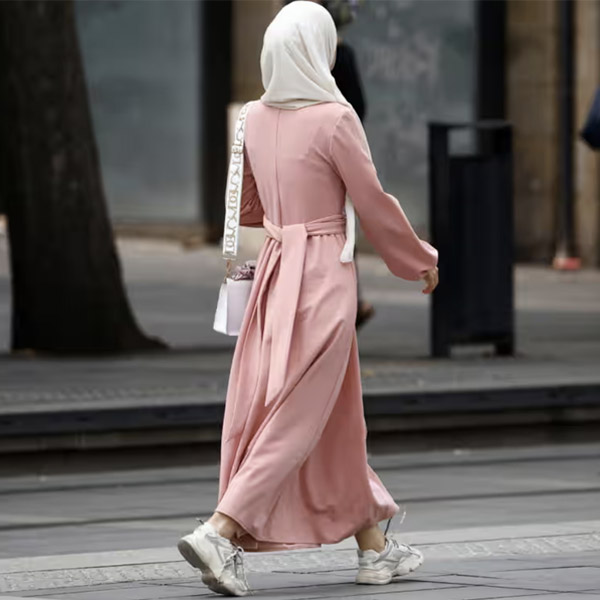
ICNA CSJDate published: Sat, 23 September 23 In early September, a top French court upheld a ban that prohibits girls in school to wear abayas. The French court found that wearing the abaya is a religious affirmation and that the ban is in line with French law that prohibits, “the wearing by pupils of signs or clothing ostensibly expressing religious affiliation, either in and of themselves, or because of the pupil’s behavior.” The government has stated that the nationwide ban of abayas, is an update to a 2004 ban on hijabs, Jewish skullcaps, or other religious paraphernalia. Earlier this year, we published an article about French secularism and the weaponization of it against minorities. Action Droits des Musulmans, an advocacy group for Muslims, filed the emergency petition that led to the court upholding the ban. They said in a statement that it was “deeply concerned about the consequences this decision could have on young girls, who risk being discriminated against on a daily basis because of their ethnic and religious appearance.” Many are questioning the government’s intentions behind continuously banning and regulating women’s clothing. Again, Muslim women are expected to regulate themselves if they want to receive education. During the beginning of the school year, girls were sent home if they showed up not only in an abaya, but if they wore a matching pant-shirt set, if they wore skirts, or if they wore anything that was seemingly loose-fitting. One girl was sent home for wearing a kimono-style cardigan (picture below). Other girls are sent home for wearing dresses, or loose shirts and pants. The ban is not just a ban on women’s religious clothing, but it is a ban on something more sinister – the existence of Muslim women in public spaces in France. When girls are banned from going to school unless they regulate their clothing, the right to education is infringed upon. Young Muslim girls are policed, regulated. This sort of environment makes it hard for these girls to pursue education, unless they give up aspects of their religious identity and self expression. C’est vrai que ce n’est pas un kimono. C’est un abaya. — Caroline Jaeger (@gloupsback) September 5, 2023 Female students in France will no longer be allowed to wear the loose-fitting abaya dress favoured by some Muslim women 👇 The move comes almost 20 years after France banned headscarves from state schools. Read more: https://t.co/svRSk56Sux pic.twitter.com/NJYfih07wb — Sky News (@SkyNews) September 4, 2023 These bans are rooted in a history of French racism and Islamophobia. France’s history with colonialism can be understood as one of the primary reasons behind its racism and institutionalized discrimination against minority groups. French colonialism was brutal. Even now, in the era of “post-colonialism,” France’s former colonies are still paying France a reparation tax – a tax for the inconvenience colonial independence caused to France. French president Macron refuses to ask for forgiveness for the crimes of the colonization of Algeria, despite Algeria’s request to do so. The teacher/principal waiting to inspect Muslim girls clothing is, in fact, wearing a long sleeve ankle length dress herself. Tell me again how this is about secularism, France? https://t.co/VSgfNq8VzP — Hannah ☪️- HLK851 on Spoutible (@HLK851) September 6, 2023 The birth of the idea of Western civilization is a precursor, or perhaps even a framework, to how race is understood today. French colonial and imperial propaganda has depicted the SWANA region, South Asia, East Asia, and Africa as lands of “backwardness, lawlessness, and barbarism tamed by French rule.” Vinecia Perkins in an article on the constitutional stratification of French ethnic minorities says that French culture sees itself as superior to all non-European cultures. The notion and rhetoric of “otherness” and pseudo-scientific racism has persisted amongst French treatment of its minorities from the expulsion of Jewish people from France to French participation in the Transatlantic slave trade. An influx of North African immigrants materialized “banlieues” (slums), plagued with rampant crime, poverty, and unemployment. More than 4.4 million people of Arab or African heritage live in banlieues where they and Jews face extreme discrimination. From the beginning, Muslims and those of African and Arab heritage have been placed on the fringes of French society by the government and natives.” Because of these aspects of institutionalized discrimination, French Muslims experience high levels of unemployment. There are studies that show that when a Muslim is considered a practicing Muslim in public, they are less likely to be called back for jobs than a secular-appearing Muslim. The European Network Against Racism published in a report about Muslim women who wear hijab, “When they get an interview and choose to present themselves with their headscarf, they take the risk of being refused for the position. Usually the headscarf monopolises the interview, employers only focus on the religious symbol and not on thecandidate’s skills. In France, as many employers think that neutrality applies to private companies, they do not hesitate to openly express the specific motive of the refusal and thus exposed themselves to condemnation in court.” France’s Islamophobia is further tied into political figures. President Macron has consistently called for targeting “radical” Islam, and pushing for a “French” version of Islam. Marine Le Penn, a far-right politician, is known for her extreme Islamophobic statements. She was a contender for the French presidency, showing that these ideas are integral to mainstream French society. Political rhetoric has created an environment where Islamophobic sentiments are on the rise, and individualized attacks occur. In 2020, Islamophobic attacks in France increased by 53%. Attacks on mosques increased by 35%. The institutionalized Islamophobia in France has created a normalization of hatred against Muslims. This not only demonizes Muslims, but increases violence against them. When faith is intertwined with French colorblind racism, the systems of oppression continue on and on, cycling for years. To address the problem, France must first acknowledge their deep institutionalized issues. https://youtu.be/WNzAaOaBtmk?si=mb4sUzlVRJA8QJOm
Labor Day – The Islamic Perspective
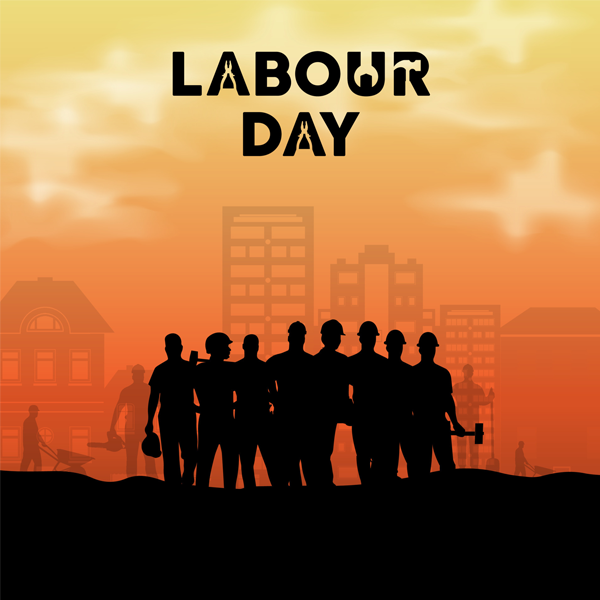
ICNA CSJ Date published: Thu, 31 August 23 This Monday is Labor Day; for many of us, this is indicative of a long weekend, perhaps you have travel plans or a bar-b-que in the works. Labor Day is a day to celebrate and recognize the labor workers that keep our country going. Between bites of hotdogs and burgers, it’s imperative that we understand that the history of Labor Day stems from the Industrial Revolution in America, a time when most people, regardless of age or gender, were working hard to contribute to America’s growing economy. This resulted in illness, abuse, long hours, and almost no breaks. As groups of workers banded together to demand better conditions, they went on strike, taking off to parade across New York City to raise awareness for their plight. Thus, the origins of Labor Day were born. Labor Day obviously has its roots in the American tradition, but the Islamic emphasis on worker’s rights is also clear. The worker, he who earns money using his labor and skill in order to provide for his family, is respected in the Islamic tradition. To work, while trusting in Allah, to better one’s condition, is an Islamic principle, and may even be considered an act of worship according to some hadith. Thus, it follows that justice towards the worker- one’s employee or laborer, is a fardh (obligation) upon every Muslim. On a small scale, we all understand what this means. Business owners who directly oversee their employees should pay fair and reasonable wages, demonstrate kindness to their employees, be understanding in cases of illness and family obligation, and pay their employees on time. Similarly, the average person, when hiring an expert to perform a service, should follow the same ideas, and treat their workers with respect. On a larger scale, however, we must understand that Islam’s emphasis on worker’s rights demands attention to policy that is shown to improve workers’ conditions. Such policies include raising the minimum wage, demanding a living wage, workday and work week caps, overtime policies, and even labor unions, which protect workers in case of oppression. Though these policies help to further justice for everyone, Muslims often find themselves removed from lobbying efforts for these policies, in comparison to policies related to the First Amendment, immigration, and even criminal justice. These, however, are essential fights to be involved in, for the betterment of our own communities, and all the hard-working people that allow this country to move forward. The AFL-CIO, or American Federation of Labor and Congress of Industrial Organizations, is an organization that works to support Labor Rights. They are the largest Labor Rights interest group in the country, and work to further causes that support workers in the United States and abroad. Their program Labor in the Minbar is an initiative to connect Muslims to the Labor Rights movement, by highlighting the importance of Union Representation, Worker’s Rights, and other important causes at the mimbar during Labor Day weekend. ( To view a preview of a khutbah about labor rights, click here) From a faith perspective, Muslims are commanded to stand up for justice and to implement the ideals of justice in our own communities and at large. This Jummah, you may or may not see representation from the AFL-CIO in your masajid, asking for your support. Your khateeb may or may not remind you of the importance of standing up for your brothers and sisters who are fulfilling the commandments of working hard for their families. Still, it is important that this year, and in the years to come, Muslims are aware of the fight for labor rights, and involved in the work of securing justice for workers. We ask that you speak about Labor Rights to your children and to those you come across this weekend. Let us begin with a well-intentioned conversation about the importance of this issue to our family and friends. You can use our Resources on Labor Rights to help you navigate these conversations. Then, we can interact with workers in our own communities, our local AFL-CIO organization, or even your nearest ICNA Council for Social Justice chapter to join a movement that is integral to our ideals of justice.
Dismantling Misconceptions about Islam Portrayed on TV

Introduction: Perceptions Shaped Through Media The role of television in today’s world is vital in shaping the perceptions of millions of individuals regarding their understanding of different cultures, religions, and communities. Unfortunately, Islam, one of the world’s largest religions, is often underrepresented or misrepresented in mainstream television shows and movies. These misrepresentations are detrimental as they perpetuate stereotypes about Muslims, influence hatred, and contribute to Islamophobia. To work against these harmful stereotypes in the media, it is important to dismantle them and understand new ways to promote accurate and nuanced portrayals. According to a report issued by the USC Annenberg Inclusion Initiative, in which researchers investigated 200 top-rated television shows from 2018 and 2019 that aired in several countries and surveyed 8,885 characters with speaking roles, it seemed that the majority of Muslim characters, if represented, were misrepresented1. Despite Muslims being the most racially and ethnically diverse group in the world, the majority of Muslim characters were depicted as Middle Eastern or North African men, and were often linked to violent acts and behaviors. While 30% of the characters were perpetrators of violence, 40% were targets of such attacks. Furthermore, less than a third were portrayed as native English speakers, highlighting Muslims as “foreigners,” according to NPR2. Muslim women were severely underrepresented, and when they were– they were portrayed as “endangered” or “fearful.” Due to a lack of understanding about Muslims and their diverse communities, stereotypes such as Muslims being violent or endangered are perpetuated in the media to bring about a wrongful understanding to individuals about what Islam truly represents. Understanding and Identifying Misrepresentation There are many examples in which Muslims are misrepresented on television, and it may be important to identify a few in order to be able to recognize them when they appear. One example is the television series “Homeland,” which depicts Muslim characters as terrorists or having terrorist sympathies. The representation in this show feeds into the narrative that Muslims are a threat to national security. According to the Harvard Political Review, “The primary goal for Carrie Mathison, the female protagonist, is to take down the fictitious terrorist leader Abu Nazir. Nazir who, along with all the other “bad guys” in the show, are Muslims.”3 While the show isn’t completely black and white and also depicts the American government as corrupt, there are many subtle instances of Islamophobia that may perpetuate stereotypes within the show. Other television shows, including “24” and “24 Legacy,” and films, such as “True Lives,” “American Sniper,” and “Executive Decision,” further associate Islam with terrorism and violence which contributes to Islamophobia. These examples highlight the need for greater diversity and accurate representation of Muslims in movies and TV shows. Correcting Misconceptions: Islam’s Stance Looking at the consistent issue of misrepresentation, it is important to understand what Islam really says about violence, terrorism, and even women’s oppression that these shows are depicting– in order to recognize the casual Islamophobia these shows portray. Islam is a religion of peace and mercy, and does not condone terrorism in any form. According to the Quran, the Holy book of Islam, and the Sunnah, the teachings of Prophet Muhammad (peace be upon him), murder is a major sin in Islam. It was even warned that on the Day of Judgement, “The first cases to be adjudicated between people on the Day of Judgment will be those of bloodshed.”4 God also says in the Quran: “God does not forbid you from showing kindness and dealing justly with those who have not fought you about religion and have not driven you out of your homes. God loves just dealers.” (Quran 60:8) The act of inciting violence or terror in the hearts of defenseless civilians, the bombing of innocent men, women and children, and the destruction of civilians’ buildings and properties, are all detestable acts in light of these Islamic texts as well as others. The violent and terroristic events associated with Muslims therefore have nothing to do with Islam, as a person who commits these actions would be guilty of violating the laws of the faith. Many are susceptible to the stereotypes regarding Islamic terrorism due to the actions of a few extremist individuals who do not represent Islam for what it truly is. What about TV shows that depict Muslim women to be oppressed? Shows such as Netflix’s Elite, which depicts a Muslim girl taking off her hijab for a guy and due to her subjection to the overbearing control of her father, push stereotypes that Muslim women are oppressed or even under a man’s control. The truth is, while the Quran and Islam emphasize the well-being of women, certain cultural traditions often discriminate against them.5 The Quran admonishes men who oppress or ill-treat women6: “O you who believe! You are forbidden to inherit women against their will. Nor should you treat them with harshness, that you may take away part of the dowry you have given them – except when they have become guilty of open lewdness. On the contrary, live with them on a footing of kindness and equity. If you take a dislike to them, it may be that you dislike something and Allah will bring about through it a great deal of good.” (Quran 4:19) Islam was one of the first religions to ban female infanticide, promote marital equality, grant women financial rights, allow for divorce, and promote shared parenting.5 However, the misalignment often arises from cultural practices, where husbands assume positions of authority, divorce is made challenging, and certain customs distort the original intent of practices such as polygamy and veiling, rendering them instruments of oppression. TV shows and films therefore portray negative cultural traditions instead of the true image of Islam. Responsibility of Media: Shaping an Informed and Inclusive Future Therefore, accurate portrayals of Islam on television are crucial for fostering understanding and promoting tolerance. TV shows and movies have the power to break down barriers and encourage dialogue by portraying the true essence of Islam, rather than continuing to showcase it as a religion
The passing of Allama Delawar Hossain Sayedee
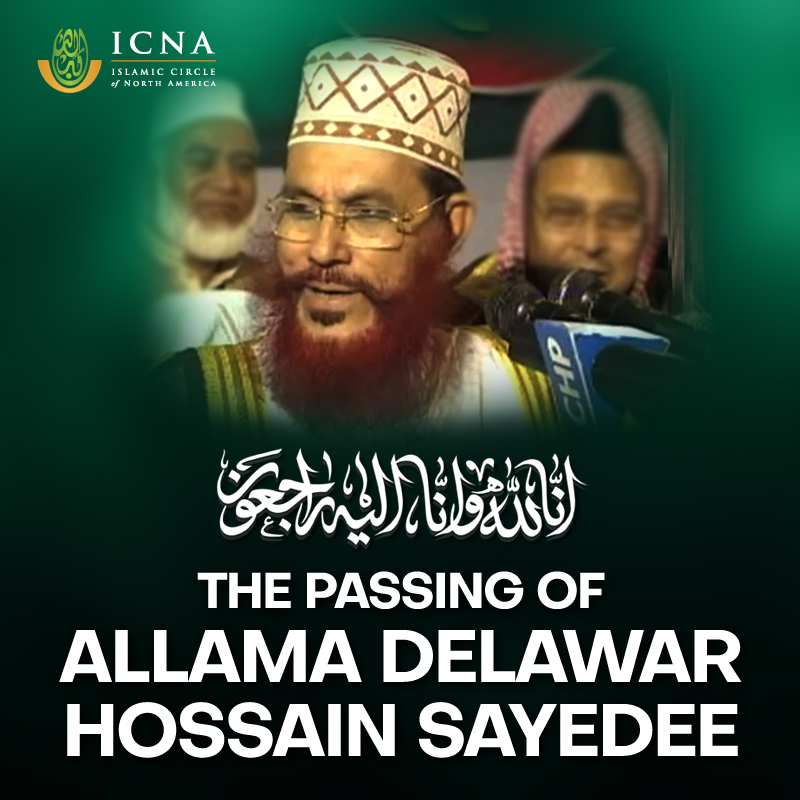
Inna Lillahi wa Inna Ilaihi Raaji’oon. The Muslim Ummah has lost a great legend. It is with profound sadness that ICNA announces the passing of Allama Delawar Hossain Sayedee while in prison. He was the Naaib Amir of Bangladesh Jamaat-e-Islami. He was an internationally acclaimed exegete (Mufassir) of the Qur’an and former Member of Parliament. This great leader was unjustly imprisoned for well over a decade and was never given a chance of a fair trial. According to reports, even his family was not allowed to meet him after his recent illness and heart attack. The death of Allama Sayedee is a great loss to this Ummah and particularly to the people and the Islamic Movement of Bangladesh. It is very difficult to describe in words the level of impact that Allama Sayedee had in the lives of people, worldwide. His passion, his dedication, his charisma, his eloquence and yet so simple and humble, were beyond captivating. He had a dynamic personality with a resoundingly impactful legacy – a truly unique icon whose contributions will benefit generations to come Insha Allah! May Allah have mercy on him and enter him into the highest levels of Paradise. Allama Delawar Sayedee has joined those great souls that have returned to Allah SWT after sacrificing all they have in this world, for Allah SWT’s sake. May Allah accept him as a martyr and fulfill his dream to become a Shaheed. By the Will of Allah their sacrifices will not be forgotten and the quest for justice and Deen continues. Inna Lillahi wa Inna Ilaihi Raaji’oon!Image Courtesy: The Muslim NewsImage Courtesy: Siliconeer.com
The Miracles of the Qur’an’s Literature: Unveiling Divine Eloquence
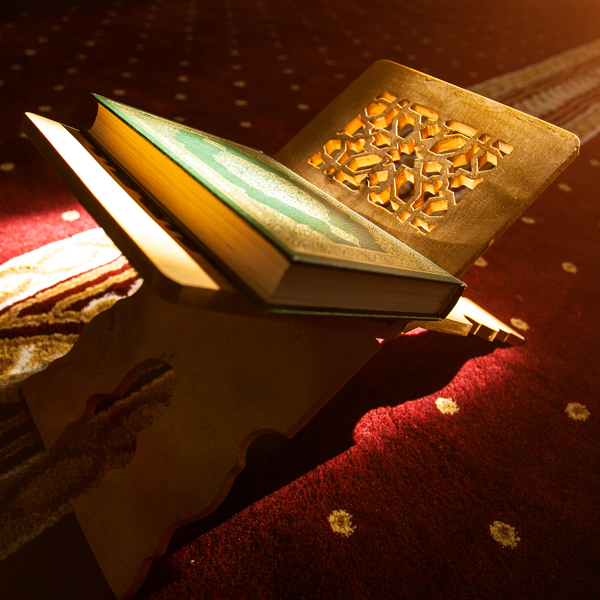
The Qur’an: A Literary Masterpiece That Transcends Generations The Qur’an, the holy book of Islam, is widely regarded as a literary masterpiece. Its profound impact on Arabic literature, its eloquence, and the timeless message it conveys have captivated both scholars and believers for centuries. The Qur’an’s literary miracles extend beyond its religious significance, enticing readers of diverse backgrounds with its linguistic brilliance and rhetorical power. In this article, we will explore some of the remarkable features of the Qur’an’s literature, shedding light on its unique qualities that attest to its divine origin. Linguistic Excellence The Qur’an was revealed in the Arabic language, and it showcases unparalleled linguistic excellence. The book’s language is pristine, with a flawless blend of eloquence, rhythm, and precision. Despite being revealed more than 1400 years ago, the Qur’an’s linguistic beauty remains unmatched. Its expressive metaphors, captivating narratives, and compelling arguments demonstrate the ingenuity of its composition, leaving a lasting impact on those who delve into its verses. For instance, Quran 54: 1-5 with their rhythmic structure and poetic eloquence, illustrate the Qur’an’s linguistic excellence. Verses 1-5 describe the event of the splitting of the moon, using concise and powerful language that evokes a sense of awe and wonder. Linguistic Miracles One of the Qur’an’s remarkable literary miracles lies in its linguistic structures and patterns. From intricate rhetorical devices to mathematical phenomena, the Qur’an displays an array of linguistic marvels. One such example is the frequent use of symmetric and balanced sentences, demonstrating a precise balance in word count and rhythmic arrangement. This structural consistency adds to the Qur’an’s aesthetic appeal and reinforces its divine nature. Chapter 55, named The Most Gracious (Al-Rahman) showcases the Qur’an’s linguistic miracles. The chapter repeatedly poses the rhetorical question, “So, which of the favors of your Lord would you deny?” This refrain creates a rhythmic pattern that emphasizes gratitude and reflection, leaving a profound impact on the reader. Eloquence and Sublimity The Qur’an’s eloquence transcends conventional human composition. Its verses possess an inherent power to stir emotions, inspire contemplation, and challenge intellect. The language flows effortlessly, captivating the reader with its profound depth. The Qur’an’s ability to evoke strong emotions and to instill tranquility in the hearts of its readers is a testament to its profound impact. Chapter 1, also known as The Opening, represents the eloquence and sublimity of the Qur’an. It is a concise chapter of seven verses, yet its words carry immense weight, expressing the believer’s plea for guidance and the recognition of Allah’s sovereignty. Vivid Imagery and Parables The Qur’an employs vivid imagery and parables to convey its messages effectively. It employs metaphorical language to paint vivid pictures in the minds of its readers, enabling them to visualize concepts and moral lessons. These literary devices enhance comprehension and create a lasting impact, fostering a deeper understanding of the Qur’an’s teachings. Chapter 16 named The Bees gives the parable of the bee and illustrates the Qur’an’s use of vivid imagery. The chapter describes the bee’s meticulous gathering of nectar and the production of honey, drawing a parallel to the order and purpose in the universe, thereby inviting reflection on Allah’s wisdom and creation. Cohesion and Thematic Unity Despite being revealed over a period of 23 years and covering various subjects, the Qur’an exhibits remarkable thematic unity. Its verses seamlessly interconnect, forming a cohesive narrative that addresses diverse topics such as theology, morality, history, and guidance for personal conduct. The coherent structure of the Qur’an testifies to its divine authorship, as the intricate interplay of themes and ideas could not have been achieved through human endeavor alone. The second chapter of the Quran is the longest chapter in the Quran. Despite its length, it exemplifies the Qur’an’s thematic unity. It covers a range of subjects, including faith, law, and guidance for the community, while maintaining a consistent narrative thread that emphasizes the importance of obedience, justice, and righteousness. Qur’an’s Unique Qualities: A Divine Testament The literary miracles of the Qur’an stand as a testament to its divine origin. Its linguistic excellence, eloquence, vivid imagery, and thematic unity all combine to create a profound impact on readers. The Qur’an’s timeless literature transcends cultural and linguistic barriers, captivating hearts and minds across generations. Its unique qualities continue to inspire, offering guidance and solace to those who seek truth. As we delve into the literary miracles of the Qur’an, we are reminded of its divine message and the endless wonders it holds for those who explore its pages.
Morality & Islam
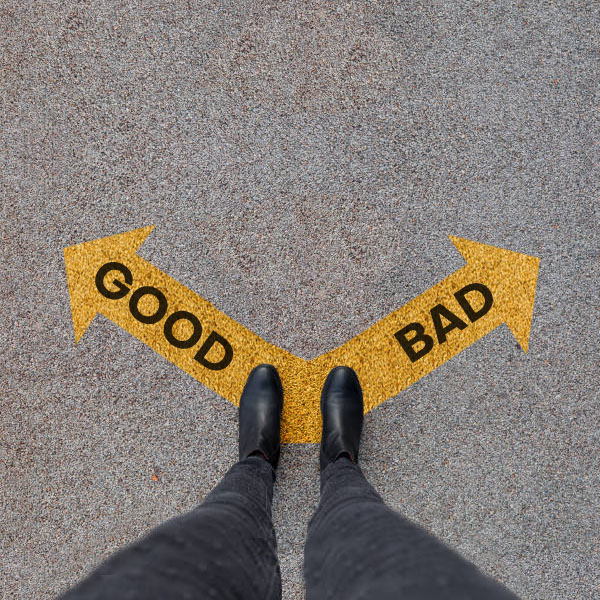
Societal Changes and Shifting Morality A few months ago, while scrolling YouTube, an 80s movie I’d watched with my son appeared. Clicking for a glimpse, I noticed the actresses’ dresses, reminiscing about how society has changed due to technology. Everything, from fashion to eating habits have changed,, and opinions on right and wrong are now up for debate as the world rapidly transforms. What is Morality and Why is it Needed? According to Oxford Dictionary morality is “a particular system of values and principles of conduct, especially one held by a specified person or society.” Humans possess a fundamental sense of morality, but its intricacies can lead to complexity. Take, for instance, those who condemn murder and capital punishment, yet support abortion as a matter of choice. If moral values are fluid and open to change according to the whims and wishes of a group of people, it would cause massive corruption as the powerful in any society will assert their influence and suppress the masses. One might argue that constitutional laws are based on logic to cater to the needs of the people. However, how do we interpret the vast difference in these laws? Consider the diverse legal age of marriage worldwide: some places allow marriage at 12, deeming it acceptable, while elsewhere, it’s classified as child abuse. Surprisingly, in California, there is no legal age for marriage while New York amended its laws not too long ago. We assume that we have the liberty and a free will to live by our wishes however we want. In reality, at any given time, we are constantly following some type of standard. It is the conditioning that we are exposed to in any given society that forms our perception and ideas about life. That is the reason why different regions have different cultures and traditions. So if the cultures are so vastly different from each other then how do we know if a certain speech or action is right or wrong? Who determines what is evil and what is good? How do we know if a certain action is beneficial or a means of corruption? One nation may be called civilized at a given time, yet a change of era may characterize that nation as not so civilized after all. Who Sets the Standards? Science is usually taken as a criterion whereby everything is based on qualitative and quantitative evidence. As we progress technologically, we are able to make better equipment to measure and experiment with. This enables us to measure things more appropriately and revise the scientific theory. There will never come a time when we can say that science can explain all the things in the universe as facts. After all, we have been in this universe for millions of years and the scientists can’t agree on some of the basic theories. Similarly, the concept of morality varies greatly across cultures and eras. Culture is also one such lens through which people view morality. In pre-Islamic days, it was an acceptable practice to bury baby girls alive. Nowadays, in some countries this same practice has shaped into aborting female fetuses. One can clearly see the problem of taking morality from culture alone. Islam’s Perspective Islam emphasizes morality and provides well-established laws and principles for a healthy society. Unlike cultural perceptions of right and wrong, Islamic laws are unchanging, yet adaptable to diverse cultures worldwide. What was immoral in the past remains so, regardless of societal norms today. The Islamic guidelines have endured the test of times and there is nothing that needs to be reformed. These laws are God centric and emanate from belief in one true God. It’s this very belief that transformed an unruly, divided pre Islamic society into one of the greatest civilizations of the world known as Islamic civilization. Oneness of God provides an anchor for a society that benefits the whole of mankind. Embracing Divine Guidance The One who created us has the wisdom to know what is good for us. Just like every sophisticated machine or program comes with its user manual, we too are given instructions to abide by so as to achieve a balance in life and prosper collectively. There is no other creation on this planet who is intellectually superior than us. Then how can we not have guidelines? One argument against Islam is that it imposes numerous restrictions, and some argue that humans should have more freedom to pursue happiness. However, consider the implications of complete freedom, like someone crossing a red light for their momentary joy. If this mindset becomes widespread, it could lead to chaotic and dangerous consequences. How Divine Guidance Shapes Society’s Well-Being and Choices As of 2020, the USA had over 16,000 rehab centers, and the numbers are increasing. However, in Medina, when divine revelation prohibited alcohol, the streets were filled with discarded alcohol, and there was no need for rehab centers. This was because the faith of the people in the Almighty and All-Wise God led them to believe in adhering to the code of life revealed by Him. This is not to take away from the importance of rehab centers, but religion and God play an important role in the healing process. Understanding that what God legislates is ultimately moral and in the best interest of the individual and society gives one strength to make the right decision. Have more questions? Call 877-WhyIslam, you deserve to know!
France’s Institutional Problems: Racism
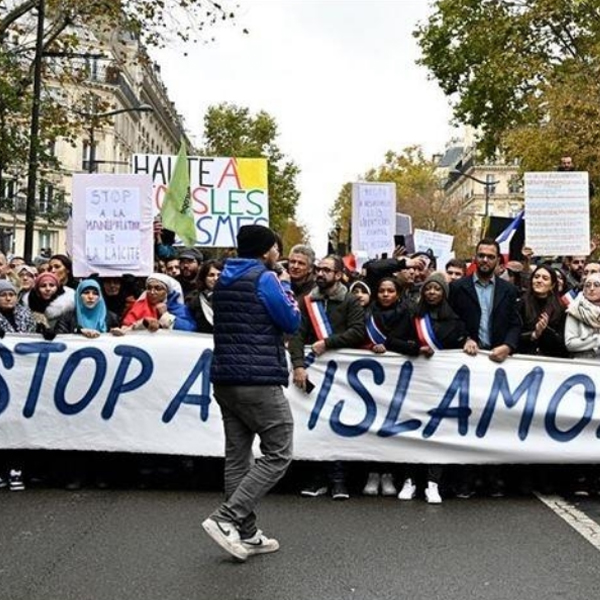
Lina B. Date published: Wed, 26 July 23 In France weeks ago, Nahel M. was killed by French police at a traffic stop. The 17-year old was from the suburbs of Paris. The killing sparked protests amongst French Algerians, French Moroccans, French Muslims, and Black French people. Most of these groups live in underserved minority areas. In Europe, racism, Islamophobia, and anti-Semitism are embedded within the fabric of society, although many Europeans will claim that color does not matter. Hiding behind perceptions of color-blindedness helps members of Europe’s privileged classes to ignore systemic issues. In many cases, it is illegal to even compile racial statistics in France . The New York Times reports an investigation by France’s Defenseur des Droit that “young men perceived to be Black or Arab” were 20 times as likely to be subjected to police identity checks than other members of the population. In any case, it is difficult to speak about race and other institutional systems in Europe, and specifically France. France’s history with colonialism can be understood as one of the primary reasons behind its racism and institutionalized discrimination against minority groups. French colonialism was brutal. Even now, in the era of “post-colonialism,” France’s former colonies are still paying France a reparation tax – a tax for the inconvenience independence of the colonies caused to France. French president Macron refuses to ask for forgiveness for the crimes of the colonization of Algeria, despite Algeria’s request to do so. The birth of the idea of Western civilization is a precursor, or perhaps even a framework, to how race is understood today. French colonial and imperial propaganda has depicted the SWANA region, South Asia, East Asia, and Africa as lands of “backwardness, lawlessness, and barbarism tamed by French rule.” Vinecia Perkins in an article on the constitutional stratification of French ethnic minorities says that French culture sees itself as superior to all non-European cultures. The notion and rhetoric of “otherness” and pseudo-scientific racism has persisted amongst French treatment of its minorities from the expulsion of Jewish people from France to French participation in the Transatlantic slave trade. In French textbooks, colonialism is taught as having positive aspects. Politician Marine Le Pen has said that French colonialism gave former colonies “a lot.” Le Pen has made an influential political career despite racist statements like this, signifying that racism in France is persistently supported. Jean Beaman in the Georgetown Journal of International Affairs wrote back in 2021 that the ethos that is put forth regarding what makes an individual French is significant in understanding French color-blindedness. The values of “liberté, égalité, et fraternité” are seen as French. If an immigrant ascribes to French Republican values, they are French. Bauman argues that this is an assimilationist framework, where “individuals relate to the state as individuals and not as members of identity groups.” French Republicanism negates race and ethnicity, not treating them as identity groups. When these markers are not treated as identity groups, there can be little to undo harm and state violence against these groups. It is clear that the French state treats those who are non-white as an inferior class of people. However, when race is not a marker of identity, then the French state can claim that there is not institutional and discrepant behavior with those of minority groups. “Part of French racial discourse is actually not even using the word “race” in government documents. And as French scholar Mame-Fatou Niang remarks, there is no French word for ‘blackness.’ Despite French Republican ideology which denies race as salient, it nonetheless structures boundaries of inclusion and exclusion.” Jean Bauman, Georgetown Journal of International Affairs
